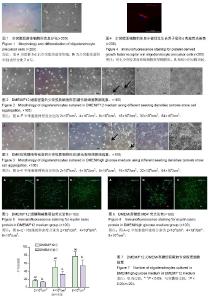| [1] McGee AW, Strittmatter SM. The Nogo-66 receptor: focusing myelin inhibition of axon regeneration.Trends in neurosciences.2003;26(4):193-198.
[2] Filbin MT. Myelin-associated inhibitors of axonal regeneration in the adult mammalian CNS.Nature Reviews Neuroscience.2003;4(9): 703-713.
[3] Fagoe ND, Eggers R, Verhaagen J, et al.A compact dual promoter adeno-associated viral vector for efficient delivery of two genes to dorsal root ganglion neurons. Gene therapy.2014;21(3): 242-252.
[4] Li L,Tam L,Liu L,et al.Wnt-signaling mediates the anti-adipogenic action of lysophosphatidic acid through cross talking with the Rho/Rho associated kinase (ROCK) pathway. Biochemistry and Cell Biology.2011; 89(6): 515-521.
[5] Morcos Y, Chan-Ling T.Concentration of astrocytic filaments at the retinal optic nerve junction is coincident with the absence of intra-retinal myelination: comparative and developmental evidence. J Neurocytol. 2000;29(9):665-678.
[6] Engel U, Wolswijk G.Oligodendrocyte-type-2 astrocyte (O-2A) progenitor cells derived from adult rat spinal cord: in vitro characteristics and response to PDGF, bFGF and NT-3.Glia.1996;16(1): 16-26.
[7] Wolswijk G,Noble M.Identification of an adult-specific glial progenitor cell. Development.1989;105(2): 387-400.
[8] Kakinuma Y,Saito F, Ohsawa S, et al. A sulfatase regulating the migratory potency of oligodendrocyte progenitor cells through tyrosine phosphorylation of β‐catenin. J Neurosci Res. 2004;77(5):653-661.
[9] Agresti C,Meomartini ME,Amadio S,et al.ATP regulates oligodendrocyte progenitor migration, proliferation, and differentiation: involvement of metabotropic P2 receptors.Brain research reviews. 2005;48(2): 157-165.
[10] 刘苹,彭锡嘉,叶剑.新生大鼠视神经少突胶质细胞原代培养及其对视神经损伤修复研究的意义[J]. 中国临床康复, 2004, 8(4):796-797.
[11] Chen Y,Balasubramaniyan V,Peng J,et al.Isolation and culture of rat and mouse oligodendrocyte precursor cells.Nature Protocols.2007;2(5):1044-1051.
[12] 陈晓静,谢敏杰.新生SD大鼠少突胶质细胞前体细胞的培养与分化[J]. 卒中与神经疾病, 2014, 21(1):11-13.
[13] Naruse M, Nakahira E, Miyata T, et al. Induction of oligodendrocyte progenitors in dorsal forebrain by intraventricular microinjection of FGF-2.Developmental biology.2006;297(1): 262-273.
[14] Chandran S,Kato H,Gerreli D,et al.FGF-dependent generation of oligodendrocytes by a hedgehog-independent pathway. Development. 2003; 130(26): 6599-6609.
[15] Wang Z,Colognato H.Contrasting effects of mitogenic growth factors on myelination in neuron-oligodendrocyte co-cultures. Glia. 2007;55(5): 537-545.
[16] Tamaki S,Tokumoto Y.Overexpression of cyclin dependent kinase inhibitor P27/Kip1 increases oligodendrocyte differentiation from induced pluripotent stem cells.In Vitro Cellular & Developmental Biology-Animal.2014;50(8): 778-785.
[17] Yang N,Zuchero JB,Ahlenius H,et al.Generation of oligodendroglial cells by direct lineage conversion. Nature biotechnology.2013;31(5):434-439.
[18] 徐明杰, 王玮.大鼠少突胶质细胞的纯化培养与鉴定[J]. 局解手术学杂志, 2008, 17(6): 379-381.
[19] Raff MC,Miller RH,Noble M.A glial progenitor cell that develops in vitro into an astrocyte or an oligodendrocyte depending on culture medium.Nature Vol.1983;303(2):390-396.
[20] Zorn TMT,Zúñiga M,Madrid E, et al.Maternal diabetes affects cell proliferation in developing rat placenta. Histology and histopathology.2011;26(7):1049-1056.
[21] Zhang Y,Guo Q,Wu M,et al.p16ink4a Expression Is Increased through 12-Lipoxygenase in High Glucose-Stimulated Glomerular Mesangial Cells and Type 2 Diabetic Glomeruli. Nephron.2015;130(2): 141-150.
[22] Abraham NG,Kushida T,McClung J,et al.Heme oxygenase-1 attenuates glucose-mediated cell growth arrest and apoptosis in human microvessel endothelial cells.Circulation research.2003;93(6): 507-514.
[23] Mayor R,Theveneau E.The neural crest. Development. 2013;140(11): 2247-2251.
[24] Mithal DS, Ren D, Miller RJ. CXCR4 signaling regulates radial glial morphology and cell fate during embryonic spinal cord development.Glia.2013;61(8): 1288-1305. |

